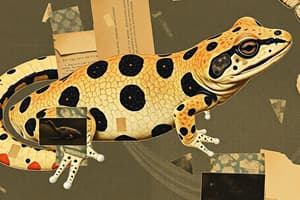Podcast
Questions and Answers
What are tetrapods?
What are tetrapods?
- Four-limbed vertebrates (correct)
- Fishes
- Invertebrates
- Reptiles
What is external fertilization?
What is external fertilization?
The process by which the female lays eggs and the male fertilizes them outside of the female's body.
What is the head of an animal?
What is the head of an animal?
The front or upper part of the body, typically containing the brain, mouth, and sense organs.
What are nares?
What are nares?
What is the primary use of the frog's tongue?
What is the primary use of the frog's tongue?
What is the tympanic membrane?
What is the tympanic membrane?
What does the nictitating membrane do?
What does the nictitating membrane do?
What is the trunk in relation to a frog?
What is the trunk in relation to a frog?
What are forelimbs?
What are forelimbs?
What are hindlimbs?
What are hindlimbs?
What is the axial skeleton?
What is the axial skeleton?
What is the appendicular skeleton?
What is the appendicular skeleton?
What is the urostyle?
What is the urostyle?
What is the femur?
What is the femur?
What is the tibiofibula?
What is the tibiofibula?
What is the humerus?
What is the humerus?
What is the radioulna?
What is the radioulna?
What is the suprascapula?
What is the suprascapula?
What are phalanges?
What are phalanges?
What is the function of the pectoralis major?
What is the function of the pectoralis major?
What does the external oblique do?
What does the external oblique do?
What is the linea alba?
What is the linea alba?
What does the latissimus dorsi do?
What does the latissimus dorsi do?
What is the gastrocnemius?
What is the gastrocnemius?
Flashcards are hidden until you start studying
Study Notes
Vocabulary and Definitions
- Tetrapod: Four-limbed vertebrates, including all vertebrates higher than fishes.
- External Fertilization: Fertilization occurs outside the female’s body; the female lays eggs, and the male fertilizes them externally.
- Head: Upper part of an animal’s body containing the brain, mouth, and sense organs, typically separated by a neck.
- Nares: Openings into the nasal cavity found in the heads of vertebrates, both internally and externally.
- Tongue: A long, sticky organ in frogs used for catching prey, which flips out to capture insects.
- Tympanic Membrane: Also known as the eardrum, this structure separates the outer ear from the middle ear and vibrates in response to sound.
- Nictitating Membrane: A transparent, eyelid-like membrane that protects the eye and enables frogs to see underwater.
- Trunk: The central part of a frog’s body, connecting the head and limbs, often referred to as the backside.
- Forelimbs: The front legs of the frog, contributing to body support and impact absorption during movements like landing.
- Hindlimbs: The back legs of the frog, primarily used for locomotion.
Skeletal System
- Axial Skeleton: Comprises the skull, rib cage, and vertebral column, forming the central axis of the body.
- Appendicular Skeleton: Includes bones that connect to the axial skeleton, such as the pectoral and pelvic girdles, limb bones, and bones of the hands and feet.
- Urostyle: A long bone connecting the sacral vertebrae, formed from fused vertebrae in frogs and toads.
- Femur: The thigh bone; it is the first leg bone.
- Tibiofibula: A lower leg bone formed by the fusion of the tibia and fibula in frogs and toads.
- Humerus: The upper arm bone; the first bone in the forelimb.
- Radioulna: The fusion of the radius and ulna; the second bone in the forelimb.
- Suprascapula: The shoulder bone, part of the pectoral girdles, characterized by its square, thin shape.
- Phalanges: The bones forming the toes on both front and back feet; referred to as separate digits.
Muscles and Functions
- Pectoralis Major: A large chest muscle responsible for moving the frog’s arms toward and away from the body, facilitating limb movement.
- External Oblique: Compresses the abdomen, aids in lateral flexion and rotation of the vertebral column, and helps in breathing.
- Linea Alba: A tendinous seam on the midline of the abdomen connecting abdominal muscles, vital for structural integrity.
- Latissimus Dorsi: A muscle that rotates and extends the forelimbs, facilitating movement of the arms towards the body.
- Gastrocnemius: A large muscle located between the knee and ankle, crucial for flexing the leg, enabling powerful movements in swimming and jumping.
Key Functions
- Frogs showcase adaptations in their anatomy that support a dual life, both in water and on land.
- The fore and hind limbs play significant roles in locomotion and body stabilization, with specialized bones for efficient movement.
- Muscular adaptations allow frogs to excel in jumping, swimming, and other activities vital for survival and feeding.
Studying That Suits You
Use AI to generate personalized quizzes and flashcards to suit your learning preferences.




